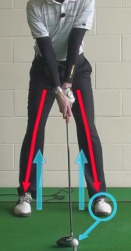
Golf equipment has advanced dramatically over the past few decades, and the swing has evolved along with it. For example, the role of the legs has changed considerably since the days of Jack Nicklaus, whose powerful lower-body action was considered the model for golfers to emulate.
In Nicklaus' day, most players turned the left knee noticeably to the right on the backswing with the left heel lifting well of the ground in many cases. On the downswing, the legs would drive toward the target, with the knees ahead of the hips, the left foot tilted onto its outside edge and the right heel lifting.
Today, most teachers advocate a “quiet” lower body that serves primarily as a base for the core muscles and shoulders – the new power center. 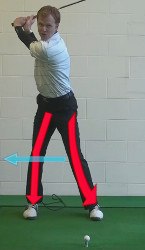 Here's a brief summary how the legs should work based on the consensus among current teaching pros:
Here's a brief summary how the legs should work based on the consensus among current teaching pros:
- Address position: 1) With the driver, the insides of the feet are directly beneath the outsides of the shoulders (e.g. shoulder width). 2) The left or lead foot is flared slightly toward the target; the right foot may be square or pointing a little right. 3) The knees should be nicely flexed and point in the same direction as the feet (not inward).
- Backswing: 1) The left knee will move to the right, but only a small amount. It should not turn so much that the heel comes more than an inch or so off the ground, if at all, depending on the player's flexibility. 2) The right knee may move slightly right, but serves essentially as a brace as the body's weight is “loaded” onto the right side.
- Downswing and follow-through: 1) Rather than racing toward the target, the knees stay beneath the hips while rotating to the left. 2) The left knee straightens (but not completely) as the club approaches impact, with the right hip and knee continuing to turn through the shot.
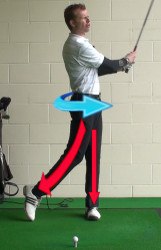
If you've been playing golf for 20 years or more and still swing with lots of leg action, a tuneup might be in order. Consult your local PGA pro, who can bring your swing up to date with today's equipment.
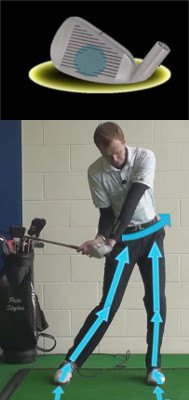
Legs Play Different Role in the Modern Golf Swing
The golf swing has changed dramatically over the years. As the game has become more and more focused on power, the way players swing the club has adapted to meet the needs of faster, more aggressive moves through the ball. Nowhere can these changes be seen more clearly than in the lower body. The average golfer today uses his or her lower body in a significantly different manner than the player of 20 or 30 years ago. Understanding how the swing has adapted, and why, can help you play better golf in the years to come.
Before we get into a detailed description of how the legs work in the modern golf swings, let's talk briefly about days gone by. Many years ago, players would allow their lower bodies to turn with the swing, especially on the way back. The left knee would rotate in toward the right knee, and the left heel would frequently come off the ground by the top of the backswing (for a right-handed golfer). This was not just limited to the amateur game – many of the best golfers in the world used this type of technique.
In the downswing, the lower body would slide toward the target, often 'running' out from under the upper body. If you have ever seen an old picture of a golfer holding a 'reverse C' finish, that finish was the result of this type of lower body movement. The legs shifted toward the target on the way down, the upper body hung back, and the club whipped through the hitting area. If you would like to take a moment to look at swing pictures of professional golfers in the 70s and 80s, you are sure to see plenty of these kinds of images.
The result of this kind of swing was perfect for playing the old version of the game of golf. The emphasis was on accuracy as opposed to distance back then, and sliding the lower body toward the target was a great way to keep the club face square for as long as possible. The entire body would essentially be moving down the line when contact was made, meaning the player had a great deal of control over his or her shots. This swing method wasn't the best for creating speed through the hitting area, but there were still plenty of top golfers who were able to develop power along with their control.
In addition to fitting the style of golf that was played decades ago, this swing method also fit the equipment that was used. Golf clubs were heavier than they are today, and the shafts were not as stiff (generally speaking). Those characteristics meant that a smooth, flowing swing was the best way to move the club through the hitting area. You couldn't move the club as abruptly as you can now, because the shaft of the clubs would not have been up to the task. With today's equipment and longer courses, a new type of swing was needed. As you will see in the content below, a new swing has indeed emerged, and it is the right way to play the game in the modern era.
All of the content below is based on a right-handed golfer. If you happen to play left-handed, please take a moment to reverse the directions as necessary.

Lower Body Keys in the Modern Game
You will have a hard time using the old-fashioned lower body action successfully when playing on modern golf courses with today's equipment. The game today is based on power, and you need to be able to generate speed at the bottom of the swing in order to keep up on the links. That's not to say that it would be impossible to play well with a sliding lower body in the downswing, but it would be considerably more difficult than it would have been in years gone by.
So, if you aren't going to swing in the old style, how should you use your lower body to produce a modern swing? The following points are a great starting point.
- Stability first and foremost. If you were to boil the responsibilities of your lower body down to just one word in the modern swing, it would be 'stable'. You want to be as stable as possible throughout the swing, both back and through, from the waist down. Think of your legs as providing a platform on top of which your upper body can work. You should have your knees flexed at the start of the swing, and you should maintain that flex throughout your action. If you are able to minimize the movement of your legs in the swing you will be moving in the right direction.
- Left heel flat. In the introduction, we mentioned how you would have commonly seen the left heel come off the ground in the swings of years gone by. That is no longer the case. Today's golfer works hard to keep the left heel on the ground as the shoulders do the job of turning away from the target. This kind of move requires flexibility in order to get back far enough to set the stage for your downswing. However, if you can make it work, you will be rewarded with a swing that has the potential for tremendous power on the way down. Do your best to keep your heel down and your swing should benefit from both a power and consistency perspective.
- Right knee in position. In keeping with the theme of stability, you are going to do your best to hold your right knee is place as the backswing develops. Allowing the right knee to drift to the right during the swing will throw your off balance and it will make it harder to create speed as well. If you can keep your right knee in place, and you can pair that with a left heel that stays on the ground, you will be doing a great job of supporting your swing with great stability in the lower half.
- Rotation in the downswing. As was mentioned above, you would have seen a lot of lateral motion in the lower body when watching older golf swings. In today's game, you will see more rotation than anything else. The hips are going to turn open to the target immediately from the top of the swing, and the upper body will follow along. Be careful to avoid lateral motion as that mistake would undo the great things you did earlier in the backswing. Open your left hip to the target immediately from the top and continue that motion all the way through impact and into the follow through.
The way the legs work in the modern golf swing is actually quite simple. It has certainly been simplified from years gone by, which is why this new swing is so much more consistent. By adding as much stability to your lower half as possible, you will find it much easier to hit the back of the ball cleanly time after time. There are fewer moving parts in this new kind of swing, and fewer moving parts almost always leads to improved results. If you are serious about building a swing which is going to hold up over the long run, taking the modern approach to the lower body is the way to go.

Personal Considerations
So far in this article, we have talked about the ideal way to use your lower body in the modern golf swing. For some golfers, it will be relatively easy to follow those instructions to the letter. If you are able to follow along with that plan, then you are certainly going to be on a good track – your lower body should be stable, and your upper body will be able to execute the rest of the swing.
However, sticking with this template might not work exactly right for all players. For instance, some golfers will find that they don't have the necessary flexibility to make this kind of swing. Without allowing the lower body to 'give' a little bit on the way back, you might find that you can't make a full turn, and you can't hit the ball very hard as a result. Or, you may feel that the modern style of swing doesn't provide you with much rhythm. Without any movement in the lower body, your swing can feel stiff and awkward. You have to respond to your own personal needs and preferences in this game, so forcing yourself to follow a strict outline for the behavior of your legs in the swing would be a mistake.
If you feel that you need to alter the plan a little bit in order to meet your needs, consider the tips below.
- Open the right foot to help your turn. If flexibility is a problem for you, it might not be necessary to let your left heel come off the ground. Instead, try opening up your right foot at address to make it a bit easier to turn away from the target. With your right foot pointing out to the right, there will be less resistance in your right side and you should be able to finish your shoulder turn. It is best to keep that left heel down if at all possible, as your swing will be more consistent if that foot stays flat. By opening the right foot in your stance, you may be able to improve your shoulder turn without sacrificing anything on your left side.
- Add flex to your knees. By getting down deeper into a 'squat' position at address, you may be able to add some athleticism to your swing without have to change anything else about your mechanics. You don't need to make a big change on this point, either – just sink a little farther down into your stance and make your swing as usual. You may find that you can turn a little better this way, and your swing should feel more dynamic and fluid as well. It is easy to get lazy and stand up straight over the ball at address, but such a stance is usually a bad thing for your game. Sit down into your stance and you will almost immediately feel better about the way your lower body is performing.
- Widen your stance. If you are not having trouble with flexibility, think about playing from a slightly wider stance to improve your stability. When your feet are farther apart, it will be easier to make a full turn without losing your balance or allowing your legs to slide from side to side. It will take some practice to get used to this kind of stance, so be sure to try it on the range before giving it a shot on the course.
In the end, it is your golf swing, and it should fit your needs. You don't want to feel like you are being forced into any specific kind of technique just because that's what most other golfers are doing. While the top pros share plenty of basic fundamentals, they also have their own individual swing characteristics. There is no such thing as the 'perfect' golf swing, and there are just about a million different ways to get the ball from point to point. Adapt the basic fundamentals of the swing to meet your own needs and you may be able to discover a technique which is perfect for you.
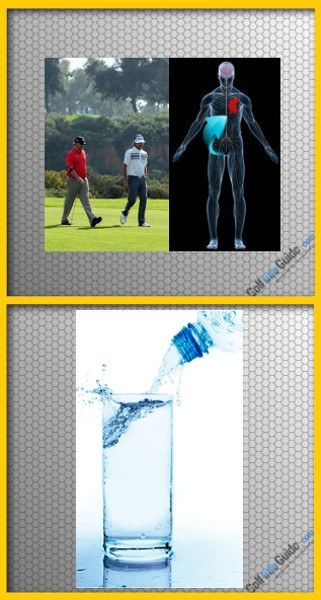
Don't Lose Your Legs
With all this talk about using your lower body effectively in the downswing, it should be mentioned that you need to do what you can to still 'have' your legs by the end of a long round. After several hours on the links, it is easy to lose your legs and have your swing start to fail you as a result. While golf is not an endurance sport by any means, you can still get tired at the end of the day if you are walking the course.
Obviously, one of the best things you can do to maintain the strength of your legs throughout a given round is to be in good physical condition. If you would like to work on your conditioning, speak with your doctor before starting a workout plan. In addition to general conditioning, you can use the tips below to maintain your legs all the way through the last hole.
- Walk a straight line. This might seem like an obvious point, but it is amazing to see how many golfers wander the fairways on their way to the ball. A full 18-hole round of golf already demands you to walk somewhere in the neighborhood of five miles – don't add to that distance by taking the 'scenic route'. Do your best to walk in a relatively straight line from shot to shot, whenever possible. The course won't let you walk in a straight line at all times, of course, as there are going to be hazards and other obstacles to walk around. Do your best to minimize the mileage, however, and your legs will thank you.
- Take a seat. If you are waiting for the group in front of you to putt out on a par three, find a bench near the tee and sit for a moment. Getting off your feet during the round, even if it is only for a minute or two, can help to rejuvenate you for the rest of the day. If there is no bench in sight around the tee, or if you are waiting in the fairway, you might even want to sit down on the grass. If the grass is wet, put a towel down first so you don't have to deal with soggy pants for the rest of the day.
- Stay hydrated. This is a great idea for a number of reasons. Allowing yourself to become dehydrated on the course will affect your performance immediately, as you will lose focus, get a headache, and become fatigued. When significant enough, dehydration can become a serious medical situation. To stay strong all the way through the finish line, drink plenty of water throughout the day. Alcoholic beverages are not a good option for hydration, so make sure you are picking something like plain water or a sports drink. You can't always count on the beverage cart to come around, so plan ahead and pack your own water, especially on hot days.
It is nearly impossible to play good golf down the stretch of a round if you are struggling to keep your legs. To give yourself the best chance to play quality golf for all 18-holes, consider the tips above to keep your legs under you. With strong legs and a focused mind, you should be able to play just as well on the final few holes as you did at the start of the round.

Your Legs and the Short Game
The short game is obviously not as demanding as the long game from a physical perspective. With that said, you do need to use your lower body properly when on and around the greens if you wish to see good results. In the short game, the story is going to be largely the same as it is with the long game when it comes to your legs – you want to emphasize stability first and foremost. If you are stable over the ball at address, and stable during your swing or stroke, you should find positive results.
One of the common lower body questions which comes up in regard to the short game has to do with the width of your stance. How far apart should you place your feet when putting or chipping? For putting, you can feel free to place your feet at any width which makes you comfortable. Some players like to stand with their feet rather wide, while some have them very close together. It doesn't really matter in the end, as long as you are balanced and comfortable.
As far as chipping is concerned, you do need to pay a little more attention to the width of your stance – especially when chipping from the long rough. Shots played from the long rough require a bigger, stronger swing, meaning you will want to have a stance which comes in on the wider side. Set your feet at least shoulder width apart for a blast from the long rough and you shouldn't have any trouble staying on balance throughout the shot.
Speaking of blasting the ball, this wide stance rule applies to bunker shots as well. When you need to splash the ball out of the sand and onto the green, set your feet slightly outside shoulder width and wiggle them into the sand slightly. From this solid base, you can make the kind of aggressive swing needed to cut through the sand and get under the ball successfully. As long as you have put the club into the sand at the right point, and you have a decent lie, the club will slide under the ball and you should be able to exit the bunker in a single swing.
While it is your upper body that is directly controlling the club during the swing, the lower body has a lot to do with your success or failure on the course. Use your legs as described in this article and you should be well on your way to quality play. While the legs were once used to slide toward the target in the downswing, today's swing is focused on rotation more than anything else. Like everything else in life, golf changes over time and you will be best served to keep up with the times. Take some time to pay attention to how your legs work in your swing if you would like to progress toward a better future. Good luck!






